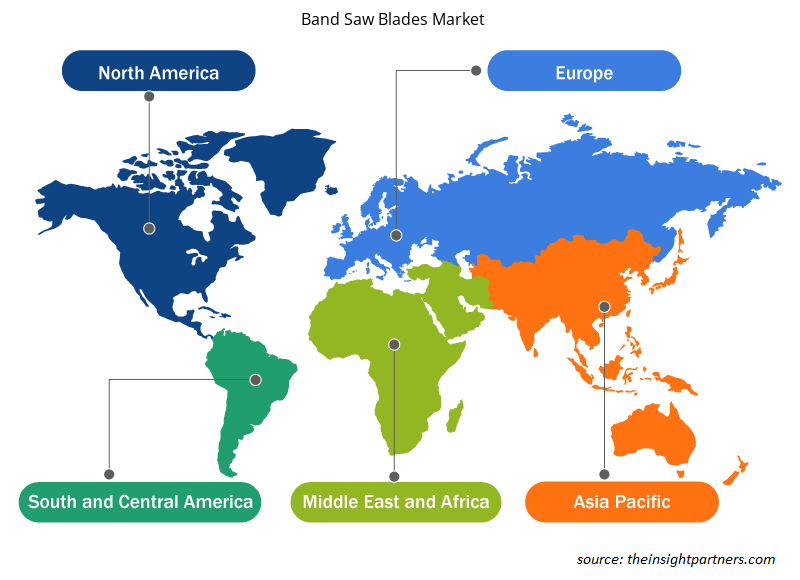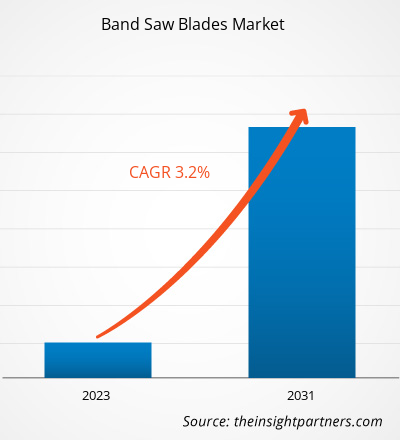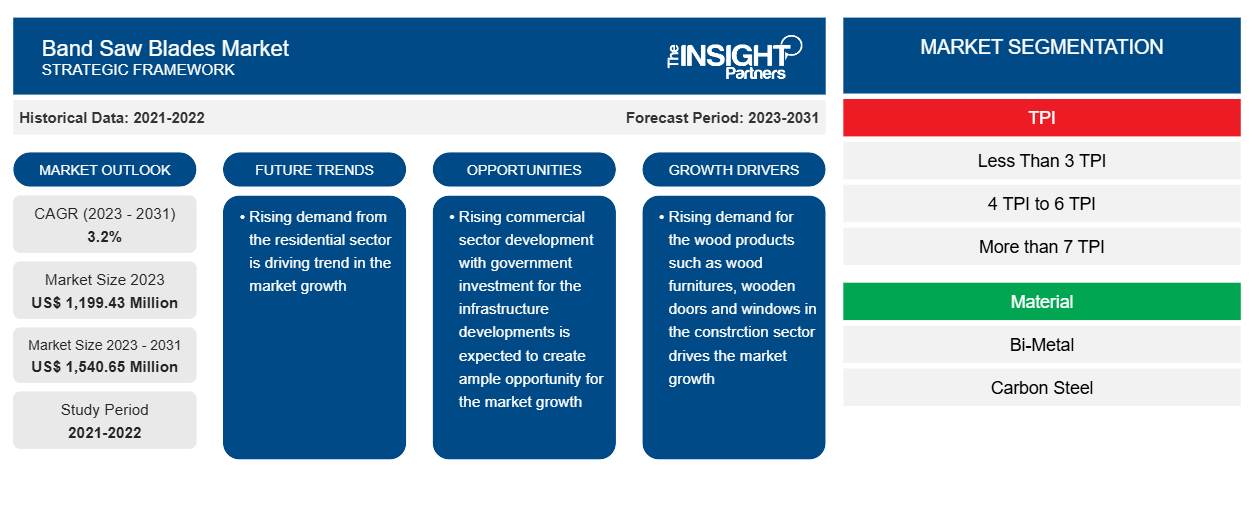Der Markt für Bandsägeblätter soll von 1.199,43 Millionen US-Dollar im Jahr 2023 auf 1.540,65 Millionen US-Dollar im Jahr 2031 anwachsen. Für den Markt wird für den Zeitraum 2023–2031 eine durchschnittliche jährliche Wachstumsrate (CAGR) von 3,2 % erwartet.
Bandsägeblätter finden vor allem in der Holz- und Metallverarbeitung Anwendung, da die Nachfrage nach grobzahnigen Sägeblättern (2 oder 3 TPI) zum Auftrennen und Schneiden dickerer Materialien sowie nach Diamantsägeblättern oder Eisensägeblättern zum Metallschneiden steigt. Wichtige Prozesse in der Holzverarbeitungsindustrie sind die Ernte und Verarbeitung von Holz und anderen Waldressourcen, die Holzernte, die Holzverarbeitung sowie die Zellstoff- und Papierverarbeitung. Unternehmen dieser Branche stellen Fertigprodukte her, die in der Bau-, Landwirtschafts- und Lebensmittelindustrie verwendet werden. Bandsägeblätter werden zur primären Holzverarbeitung verwendet.
Bandsägeblätter Marktanalyse
Bandsägeblätter werden in verschiedenen Branchen zum Schneiden verwendet, darunter in der Landwirtschaft, beim Möbelschneiden und bei der Metallverarbeitung. Die Bandsägeblätter sind in der Maschine montiert, die die Räder und den Motor umfasst. Diese Bandsägeblätter werden zum Sägen und Schneiden von Hartmetallen wie Kobalt, Zirkonium, Nickel, Eisen, Titan, Holz, Asphalt, Beton, Marmor, Granit und anderen Metallen verwendet. Diese Blätter sind verschleißfest und korrosionsfrei und zur Verbesserung ihrer Festigkeit mit Kobalt, Nickel und Kohlenstoffstahl legiert.
Marktübersicht für Bandsägeblätter
Bandsägeblätter sind auswechselbare, gezahnte Schneidblätter, die in vielen Handgeräten sowie tragbaren und stationären Elektrowerkzeugen verwendet werden. Die Holzindustrie in Europa ist eine der bemerkenswertesten Branchen, da sie einen erheblichen Teil der Wirtschaft der Region erwirtschaftet. Die europäischen holzbasierten Industrien umfassen eine breite Palette von nachgelagerten Betrieben, wie die Holzverarbeitung, bedeutende Sektoren der Möbelindustrie, die Zellstoff- und Papierherstellungs- und -verarbeitungsindustrie sowie die Druckindustrie. Laut den von Eurostat im Jahr 2022 bereitgestellten Daten betrug die Bruttowertschöpfung (BWS) der holzbasierten Industrien in der EU im Jahr 2020 136 Milliarden Euro, was 7,2 % der gesamten verarbeitenden Industrie ausmachte. Im Jahr 2020 betrug die Bruttowertschöpfung der Produktion von Holz und Holzprodukten 37 Milliarden Euro. Die höchste BWS in der holzbasierten Industrie der EU wurde in den Bereichen Zellstoff, Papier und Herstellung von Papierprodukten gemeldet (34 % oder 46 Milliarden Euro). Auf den Druck und die druckbezogenen Dienstleistungstätigkeiten entfielen 16 % der Bruttowertschöpfung der holzbasierten Industrie, während die Möbelherstellung sowie die Holz- und Holzproduktherstellung jeweils zwischen 23 % und 27 % der Bruttowertschöpfung der holzbasierten Industrie ausmachten.
Passen Sie diesen Bericht Ihren Anforderungen an
Sie erhalten kostenlose Anpassungen an jedem Bericht, einschließlich Teilen dieses Berichts oder einer Analyse auf Länderebene, eines Excel-Datenpakets sowie tolle Angebote und Rabatte für Start-ups und Universitäten.
-
Holen Sie sich die wichtigsten Markttrends aus diesem Bericht.Dieses KOSTENLOSE Beispiel umfasst eine Datenanalyse von Markttrends bis hin zu Schätzungen und Prognosen.
Markttreiber und Chancen für Bandsägeblätter
Eine weltweite Zunahme der Holz- und Metallverarbeitung treibt das Marktwachstum an
Unternehmen dieser Branche stellen Fertigprodukte her, die in der Bau-, Landwirtschafts- und Lebensmittelindustrie verwendet werden. Bandsägeblätter werden für die primäre Holzverarbeitung verwendet. Fortschritte in der Metallverarbeitung haben den Bedarf an Geräten und Werkzeugen erhöht, die Vibrationen und Lärm dämpfen. Komfort und einfache Handhabung der Geräte sind wichtige Aspekte bei der Metallverarbeitung. Daher besteht eine erhöhte Nachfrage nach langlebigen Bandsägeblättern, die lange halten, um Ausfälle und Ausfallzeiten zu vermeiden. Der Aufstieg des CNC-Maschinenherstellungsprozesses unterstützt das Wachstum der industriellen Metallverarbeitungsbranche. Das Aufkommen der CNC-Technologie, technologische Fortschritte, innovative Produktentwicklungen und die steigende Nachfrage nach Elektrowerkzeugen und Roboter-Holzbearbeitungsmaschinen sind weitere Faktoren, die das Wachstum des Marktes für Bandsägeblätter ankurbeln. Darüber hinaus treibt die zunehmende Verbreitung fortschrittlicher Technologien den Verkauf von Bandsägeblättern in der Holz- und Metallverarbeitungsindustrie voran.
Marktteilnehmer mit umfassender Erfahrung in der Holzverarbeitungsindustrie arbeiten eng mit Holzverarbeitungsunternehmen zusammen, um deren Produkte zu entwickeln, zu modernisieren und zu automatisieren und Systeme zur Überprüfung der Produktqualität und Produktionsdiagnose zu implementieren. Die Möbelindustrie verzeichnet ein deutliches Wachstum. Der Markt für Holzverarbeitungsmaschinen wächst in den USA und China. Weitere wichtige Märkte für die Holzverarbeitungsindustrie sind Japan, Kanada und Deutschland, die das Wachstum des globalen Marktes für Bandsägeblätter vorantreiben.
Ausbau der Bauprojekte in den Entwicklungsländern
Die Nachfrage nach Bandsägeblättern zum Schneiden, Zusammenbauen und Reparieren von Holz- und Metallkonstruktionen steigt in den Volkswirtschaften des asiatisch-pazifischen Raums, des Nahen Ostens und Südamerikas. In den kommenden Jahren wird der asiatisch-pazifische Raum voraussichtlich führend auf dem Markt für Bandsägeblätter sein, da die Verkäufe der Blätter in der Region aufgrund der steigenden Zahl von Bauprojekten steigen. So ist beispielsweise die Chipfabrik in Shanghai, China, eines der größten Bauprojekte, das im ersten Quartal 2022 im asiatisch-pazifischen Raum begonnen wurde. Die Bauarbeiten sollen bis 2024 abgeschlossen sein. Ebenso soll der Bau einer 12-Zoll-Wafer- und integrierten Schaltkreisverpackungsanlage in Peking, China, zur Deckung der wachsenden Nachfrage nach integrierten Schaltkreisprodukten bis 2024 abgeschlossen sein. In Indien nimmt die Metallverarbeitung rasant zu, um Einzelteile, Baugruppen und großformatige Metallformen für riesige Schiffe, Motorteile und viele Endverbrauchsindustrien herzustellen, was die Nachfrage nach Bandsägeblättern zum Formen, Schneiden und Verbinden von Formen erhöht hat. Darüber hinaus ist im Land ein erhöhter Bedarf an Stahl zu verzeichnen, da die Automobil- und Bauindustrie zunehmend nachfragen und die Regierung verstärkt auf die Entwicklung der Infrastruktur setzt. Branchenvertretern zufolge werden das Wachstum spezieller Güterkorridorprojekte, neuer Hochgeschwindigkeits- und Semi-Hochgeschwindigkeitsprojekte sowie die Beschaffung von Schienenfahrzeugen den Stahlverbrauch ankurbeln.
Segmentierungsanalyse des Marktberichts für Bandsägeblätter
Wichtige Segmente, die zur Ableitung der Marktanalyse für Bandsägeblätter beigetragen haben, sind TPI, Material und Anwendung.
- Basierend auf TPI ist der Markt in weniger als 3 TPI, 4 TPI bis 6 TPI und mehr als 7 TPI unterteilt. Die zunehmende Anwendung von 4 TPI bis 6 TPI-Sägeblättern zum Schneiden von Weichstahl oder geglühtem Material treibt das Segmentwachstum voran. Marktteilnehmer im 4-TPI- bis 6-TPI-Segment bieten eine ideale Anzahl von Zähnen unter Berücksichtigung der Wandstärke, um vorzeitigen Sägeblattverschleiß oder Motorausfälle zu vermeiden. Solche Faktoren werden voraussichtlich das Wachstum des 4-TPI- bis 6-TPI-Segments auf dem globalen Markt für Bandsägeblätter ankurbeln.
- Je nach Material ist der Markt in Bimetall, Kohlenstoffstahl und andere unterteilt. Unter diesen hat Bimetall im Jahr 2023 den größten Anteil.
- Basierend auf der Anwendung ist der Markt in Holzschneiden und Fleischverarbeitung segmentiert . Das Holzschneiden ist im Jahr 2023 das dominierende Segment aufgrund der zunehmenden Anwendungen bei Wohnmöbeln.
Marktanteilsanalyse für Bandsägeblätter nach Geografie
Der geografische Umfang des Marktberichts für Bandsägeblätter ist hauptsächlich in fünf Regionen unterteilt: Nordamerika, Asien-Pazifik, Europa, Naher Osten und Afrika sowie Südamerika/Süd- und Mittelamerika.
Aufgrund der steigenden Bevölkerungszahl, der wachsenden Kaufkraft der Bevölkerung und der rasanten Urbanisierung in den Entwicklungsländern der Region wird Nordamerika voraussichtlich den Markt dominieren. Die Hersteller von Bandsägeblättern entwickeln neue Produkte, die hochwertige Schnitte für verschiedene Metallschneideanwendungen bieten. Die Produktinnovationsstrategie konzentriert sich in erster Linie auf die Verbesserung der Leistung und Haltbarkeit von Blättern für das Präzisionsmetallschneiden. Der harte Wettbewerb auf dem Metallschneidemarkt ist einer der Hauptfaktoren, der die Hersteller dazu ermutigt, Produktinnovationsstrategien zu verfolgen. Einer der führenden Hersteller von Bandsägen und Handfeilenprodukten bietet eine neue Reihe von Bimetall-Bandsägeblättern mit spezifischen Tiefen für alle Metallschneideanwendungen an, darunter Allzweckschneiden, Produktionsschneiden, Weichstahlschneiden und Härteschneiden exotischer Legierungen.
Regionale Einblicke in den Markt für Bandsägeblätter
Die regionalen Trends und Faktoren, die den Markt für Bandsägeblätter im Prognosezeitraum beeinflussen, wurden von den Analysten von Insight Partners ausführlich erläutert. In diesem Abschnitt werden auch die Marktsegmente und die Geografie von Bandsägeblättern in Nordamerika, Europa, im asiatisch-pazifischen Raum, im Nahen Osten und Afrika sowie in Süd- und Mittelamerika erörtert.

- Erhalten Sie regionale Daten zum Markt für Bandsägeblätter
Umfang des Marktberichts über Bandsägeblätter
| Berichtsattribut | Details |
|---|---|
| Marktgröße im Jahr 2023 | 1.199,43 Millionen US-Dollar |
| Marktgröße bis 2031 | 1.540,65 Millionen US-Dollar |
| Globale CAGR (2023 - 2031) | 3,2 % |
| Historische Daten | 2021-2022 |
| Prognosezeitraum | 2023–2031 |
| Abgedeckte Segmente |
Von TPI
|
| Abgedeckte Regionen und Länder |
Nordamerika
|
| Marktführer und wichtige Unternehmensprofile |
|
Marktteilnehmerdichte: Der Einfluss auf die Geschäftsdynamik
Der Markt für Bandsägeblätter wächst rasant, angetrieben durch die steigende Nachfrage der Endverbraucher aufgrund von Faktoren wie sich entwickelnden Verbraucherpräferenzen, technologischen Fortschritten und einem größeren Bewusstsein für die Vorteile des Produkts. Mit steigender Nachfrage erweitern Unternehmen ihr Angebot, entwickeln Innovationen, um die Bedürfnisse der Verbraucher zu erfüllen, und nutzen neue Trends, was das Marktwachstum weiter ankurbelt.
Die Marktteilnehmerdichte bezieht sich auf die Verteilung von Firmen oder Unternehmen, die in einem bestimmten Markt oder einer bestimmten Branche tätig sind. Sie gibt an, wie viele Wettbewerber (Marktteilnehmer) in einem bestimmten Marktraum im Verhältnis zu seiner Größe oder seinem gesamten Marktwert präsent sind.
Die wichtigsten auf dem Markt für Bandsägeblätter tätigen Unternehmen sind:
- BAHCO (SNA Europa)
- Dongbei Spezialstahl Group Co., Ltd.
- Friedrich Bickenbach GmbH & Co.
- KG
- Gi-Esse Salvador Srl
- HABUR -SAWS GmbH
Haftungsausschluss : Die oben aufgeführten Unternehmen sind nicht in einer bestimmten Reihenfolge aufgeführt.

- Überblick über die wichtigsten Akteure auf dem Markt für Bandsägeblätter
Neuigkeiten und aktuelle Entwicklungen zum Bandsägeblattmarkt
Der Markt für Bandsägeblätter wird durch die Erhebung qualitativer und quantitativer Daten nach Primär- und Sekundärforschung bewertet, die wichtige Unternehmensveröffentlichungen, Verbandsdaten und Datenbanken umfasst. Im Folgenden finden Sie eine Liste der Entwicklungen auf dem Markt für Innovationen, Geschäftserweiterungen und Strategien:
- Diablo Tools („Diablo“), das eine lösungsorientierte Palette der besten Produkte der Welt und der besten für unsere Welt für den professionellen Anwender anbietet, stellt eine weitere Branchenneuheit auf dem Markt für oszillierende Multifunktionswerkzeuge („OMT“) vor: das AMPED™ Demo Demon™ Hartmetallzahnblatt für nagelbesetztes Holz. Dieses erste Hartmetall-OMT-Blatt seiner Art wurde speziell für nagelbesetztes Holz entwickelt und bietet anwendungsspezifische Vorteile und bahnbrechende Innovationen für Profis. (Quelle: Pressemitteilung des Unternehmens, April 2024)
- Die KR Saws-Tochter Roentgen, ein renommierter deutscher Marktführer für industrielle Schneidlösungen, hat ihre neueste Innovation vorgestellt, die speziell auf das Sägen von nickelbasierten Legierungen zugeschnitten ist. Das Roentgen Fit Set und das Fit Bandsägeblatt wurden entwickelt und hergestellt, um die Schneidleistung zu steigern, die Lebensdauer des Werkzeugs zu verlängern und traditionelle Einlaufverfahren überflüssig zu machen, was letztlich wertvolle Zeit und Ressourcen für Metallhersteller und Ingenieure spart. Nickelbasierte Legierungen wie Inconel 718 und 625 sind für ihre außergewöhnliche Festigkeit, Korrosionsbeständigkeit und Hochtemperatureigenschaften bekannt und stellen für herkömmliche Schneidwerkzeuge eine Herausforderung dar. (Quelle: Pressemitteilung des Unternehmens, März 2024)
Marktbericht zu Bandsägeblättern – Umfang und Ergebnisse
Der Bericht „Marktgröße und Prognose für Bandsägeblätter (2023–2031)“ bietet eine detaillierte Analyse des Marktes, die die folgenden Bereiche abdeckt:
- Bandsägeblätter Marktgröße und Prognose auf globaler, regionaler und Länderebene für alle wichtigen Marktsegmente, die im Rahmen des Berichts abgedeckt sind
- Marktdynamik wie Treiber, Beschränkungen und wichtige Chancen
- Markttrends für Bandsägeblätter
- Detaillierte PEST-Analyse und SWOT-Analyse
- Marktanalyse für Bandsägeblätter, die wichtige Markttrends, globale und regionale Rahmenbedingungen, wichtige Akteure, Vorschriften und aktuelle Marktentwicklungen abdeckt.
- Markt für Bandsägeblätter: Branchenlandschaft und Wettbewerbsanalyse, einschließlich Marktkonzentration, Heatmap-Analyse, prominenten Akteuren und aktuellen Entwicklungen.
- Detaillierte Firmenprofile
- Historische Analyse (2 Jahre), Basisjahr, Prognose (7 Jahre) mit CAGR
- PEST- und SWOT-Analyse
- Marktgröße Wert/Volumen – Global, Regional, Land
- Branchen- und Wettbewerbslandschaft
- Excel-Datensatz
Aktuelle Berichte
Erfahrungsberichte
Grund zum Kauf
- Fundierte Entscheidungsfindung
- Marktdynamik verstehen
- Wettbewerbsanalyse
- Kundeneinblicke
- Marktprognosen
- Risikominimierung
- Strategische Planung
- Investitionsbegründung
- Identifizierung neuer Märkte
- Verbesserung von Marketingstrategien
- Steigerung der Betriebseffizienz
- Anpassung an regulatorische Trends























 Kostenlose Probe anfordern für - Markt für Bandsägeblätter
Kostenlose Probe anfordern für - Markt für Bandsägeblätter